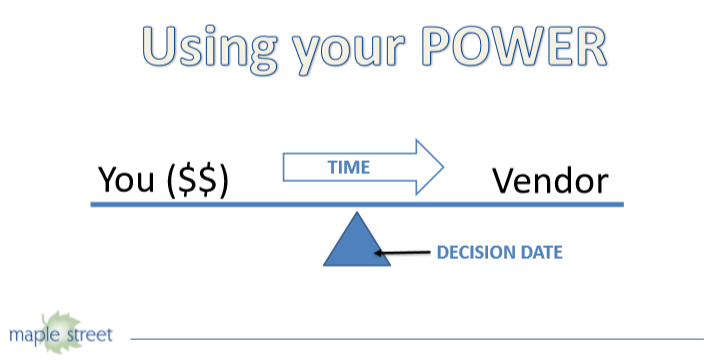Written by Chris Monti, Senior Negotiator
The most effective tool for a successful negotiation project is time. Although time is what busy professionals have the least of in the day, time is what ensures we have the strongest position in every stage of the vendor selection process.
If you’re not a professional negotiator, you might not be aware of the actual amount of time needed to successfully renegotiate the terms or to negotiate with a new vendor, terminate the old one and have a seamless transition. A few months may seem like plenty of time, but vendors know stonewalling can allow them to gain the advantage and a five-year contract can rollover without significant changes in your favor.
At Maple Street, we are master negotiators who have saved credit unions and community banks $110 million and counting. Throughout our tenure, we have found the key to success in negotiations always comes down to one thing – time.
Put time on your side
Why don’t people put time on their side in negotiations?
A common reason is the chaos that ensues when multiple contracts are expiring simultaneously. Deciding which contracts to focus on, let rollover or terminate can be overwhelming. Another frequent reason is branch and operational priorities can prevent starting the project. Even with the best of intentions, daily tasks can get in the way and negotiations can easily become overshadowed.
Putting time on your side in negotiations has been found to have a direct and positive correlation on the final price and contract terms, vendor performance and accountability.
When to get started
The time you need to spend in negotiations depends on the results you want to get. The more you’re rushing the process because you’re short on time, the more likely you won’t get the contract you want. We recommend starting as soon as possible to achieve the best results for your institution.
Time tilts the balance of power
Think of negotiating as being on a seesaw – you’re on one side and your vendor is on the other. Adding weight to your side is the price you’re willing to pay and on the vendor’s side it’s the service they want to sell. The pivoting point in the middle is the decision date.

At Maple Street, we know securing the best contracts, including terms, pricing and performance, depends on who has the power to tilt the seesaw on their side. The secret to negotiating power often lies in a competitive force. If a vendor realizes you have another vendor waiting in the wings, they’re more willing to negotiate the terms and price you want.
Making competitive leverage requires time and planning. The closer you get to the decision date, the less time you’ll have to create the power needed to come out on top.
Planning and research lead to more dollars
Successful negotiation requires three parts: planning, proposals and education. In planning, we lay the groundwork for success by determining the purpose and desired outcome of the negotiation. Once this crucial step is complete, we must decide what strategy will achieve the end goal. In other words, we need to determine what force we’ll utilize with each vendor and when to introduce them.
To use leverage, we need the time to send out RFPs and review proposals. Proposals take significant time to review, evaluate and narrow the field down to two or three through a process of education and vetting. Once we determine possible replacement vendors we are ready to begin negotiations.
Negotiating takes more time than that spent at the table. The more time we have to plan and prepare for negotiations, the better chance we have to achieve optimal results. With time on our side, we don’t need to accept a vendor’s first offer.
After reviewing the results of the initial negotiations, Maple Street’s team negotiates again, gaining additional favorable outcomes. Each new proposal will be reviewed and shared with our client to determine if this is the best deal possible. If we think more can be won and we have time, we’ll continue negotiating until we have achieved the best possible results.
Maple Street has a proven track record in negotiating major savings for credit unions and community banks. Email us at info@MapleStreetInc.com or call (321) 257-3930 to learn more about how we can your institution thrive.